#my theory re the abrasive blacks thing
Explore tagged Tumblr posts
Note
Okay, so related to my ask about the only picture truly left of Sirius being the one of him laughing as he’s arrested, I have also decided that Narcissa sends him a copy of his and Bella’s arrest photos. At some point, Sirius gets an untraceable package and it consists solely of the photos of him and Bellatrix laughing as they get arrested (he can see the other 3 in the background but Bellatrix dominates her photo, just like she always has) and a note saying “I thought these photos were particularly fitting. For obvious reasons I couldn’t send them to you or Bella earlier, but I’m sure you’ll get the joke. Don’t die.” There’s no signature but Sirius recognizes Narcissa’s handwriting and he does indeed get the joke (it’s not particularly funny, but it’s “no matter how hard you try, you’ll never not be a Black. Nobody will ever see anything but our family when they look at you; you can never outrun the Black blood in your veins”). It’s also a tad cruel, as Sirius is very aware of how similar he and Bellatrix look in that picture and he’s just as aware that Narcissa would’ve been as well and wanted to make him think of it too, but the Blacks’ form of communication is about 20% jabs that everyone else would consider too cruel to ever be forgiven but they say those comments as conversation over breakfast so he’s not too upset. Sirius sends back an old newspaper scrap with the owl, making sure there’s no way to identify where he got it or track him with it, and scrawls “Thanks. You used to be a lot funnier” on it. He knows Narcissa will know this means he’s alive, he got the joke, and he’s not truly mad at her. I like to think that Sirius takes the photos with him to Grimmauld and the Order is rather confused about why he’s chosen to keep photos of him and his lunatic cousin laughing as they get arrested. I also choose to think Narcissa made a copy of the photos and she gives them to Bella when she gets out, and all three of them are aware just why Narcissa kept them and what her message is with them. For crack purposes, all the other Death Eaters have to see the photos and words cannot describe how unsettling it is to see Sirius Black and Bellatrix Lestrange laughing madly as they’re surrounded by over a dozen Aurors; for all that they’re on opposing sides, they look near-identical in the pictures. Narcissa and Bella are the only ones who don’t find the pictures creepy (other Death Eaters have brought it up to Lucius who shrugs helplessly and rolls his eyes because he’s lost this argument 3 times and he won’t try for a fourth time so they’re on their own)
that this also lends credence to the androgyny of sirius’ appearance pleases me on a level i cannot articulate.
also the last point lmaooo i love how detailed ur stuff is bc i can imagine it happening perfectly. the look of resignation on lucius’ face, the alarm on everyone else’s, the mix of cruelty-humor that the blacks are known for (and that make them too abrasive for everyone else)
#sirius black#my theory re the abrasive blacks thing#bc i have to include j/s in everything#is that james was the only non-black who got completely used to this trait#without taking it personally and the spirit it was intended in#he never quote developed the ability to give as good as he got#bc he doesn’t have that inherent edge#but he got remarkably good at fielding them#and just. not becoming instantly uncomfortable like literally everyone else when the black siblings r bantering#and this meant the other blacks had a grudging amount of respect for him no matter how much they tried otherwise#bc anyone who can sit at a table w them and not get scared away or call the auroras has some measure of backbone#and they can appreciate that#pen’s asks#the BFCU
14 notes
·
View notes
Text
Anyways! Corpse Party 2 theory
i’ve had this thought in my head for years a;sdlkajsfd;j but i’ve had a theory that Masami’s goal is, for whatever reason (and idk how this ties into Ayame being a Dead Patient herself) that the goal -or one of them- of what is happening in Amare Patriarcha Crucis Hospital is a “recreation” of the Heavenly Host incident that destroyed Kisaragi Academy’s Class 2-9 by Masumi due to the following similarities:
both incidents consist of survivors consisting mainly of high school students and one adult (Kisaragi Academy Class 2-9 and Minazuki Academy Class 1-5, although the later has an unrelated adult woman with them as opposed to a trusted teacher)
both take place in locations where they cannot leave (Heavenly Host is separated from the rest of reality and Amare Hospital is surrounded by armed soldiers who will not allow the trapped to leave)
both include an antagonistic figure wearing red (Sachiko in Heavenly Host, the Woman in Red in Amare Hospital)
in both incidents the primary obstacles are zombies and malicious spirits: however while Heavenly Host only had one noteworthy zombie (Yanagihori) and the main threats were spirits Amare Hospital has only been shown to have a few spirits of unknown alignment with the main threat being zombies
Class 2-9 had to search for the items to appease Sachiko and the ghosts, and while we still haven’t seen Chapter 2 in 7 years it was stated in the drama CDs that Masumi intended to have Class 1-5 participate in some kind of “scavenger hunt” in the hospital
even the characters have similarities:
Ayame’s personality is basically a mix between Satoshi and Naomi, being the team leader while having Naomi’s overall demeanor and the central focus character, but unlike COPA1 it takes place entirely from her POV
Chiyomi is the Not!Seiko (a common Kedouin trope) as an energetic and somewhat lewd girl who clearly has a crush on Ayame, although she’s a bit more ditzy than Seiko was
Curara is a mix between Mayu and Ayumi being the highly adored and most popular girl in school (if I remember right) to the point of being somewhat of an idol, while also being the class representative with a lot of responsibilities
Ryuji is basically Morishige as a kid involved with theater and being Curara’s most important friend she’s known since childhood while also having black hair and glasses. Hell, he even canonically knew Morishige and was friends with him before he died.
the only really extreme difference is between Ritsuko and Yui. Wheras Yui was an incredibly dedicated teacher for her students and would gladly give her life for them Ritsuko was an abrasive adult with NO intention of dying for a bunch of kids she didn’t know and almost left them to die at one point, and when becoming a member of this team properly instead of just accepting her role as a sensei or adult figure pledges her loyalty to Ayame and even starts calling her Ayame-sama. I fucking loved that.
Satoshi was involved in both incidents.
listen idk much about Blood Drive (just got it on Steam) but it’s filled with douchebags and i’m sure Masami could be compared to one of them as an ammoral doctor occult person
now take all of this with a grain of salt: Kedouin is kind of a hack who loves to re-use his ideas over and over with his only non Corpse Party work of note being the completed manga Dolls Fall (which shares some similarities in that it is also a gore manga about kids complete with a Seiko expy but it did have some cool things like magic I think I can’t remember) and has basically been forcing this franchise to be alive for years despite no new actual content since Blood Drive and considering how quickly he initially gave up on COPA2 it’s very possible Kedouin was just trying to not use any new ideas as possible and is quite possibly only returning to it because his money train is running dry
but... it’s kind of a fun thought, isn’t it? that Masami is basically pulling off an S3 Plan in COPA2 intentionally? i think it is, anyways
27 notes
·
View notes
Photo
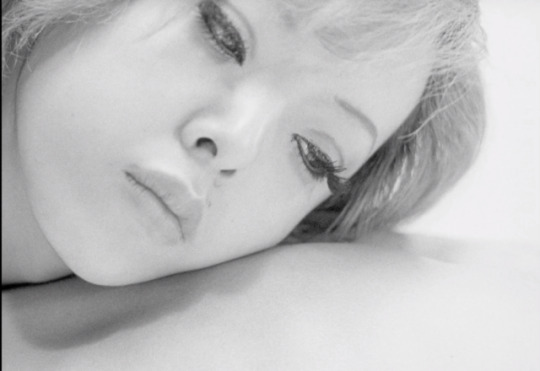

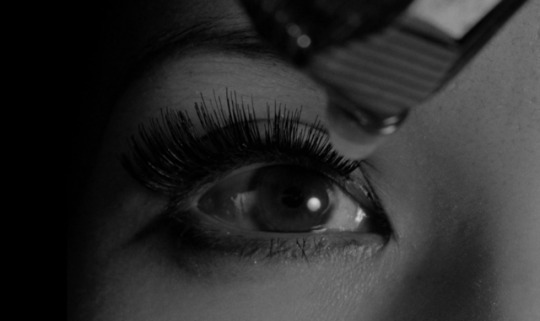
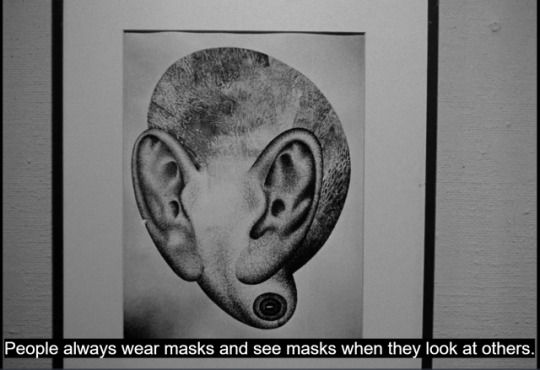
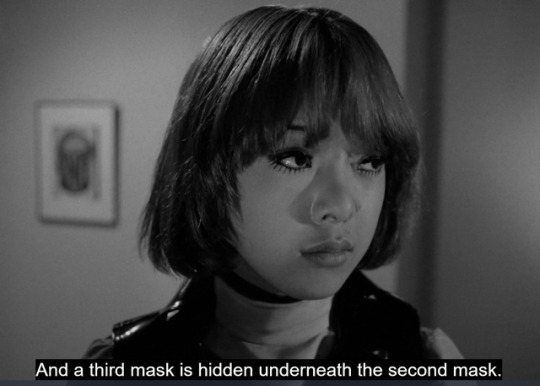

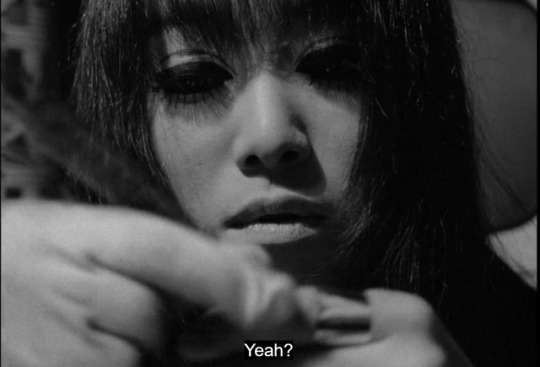
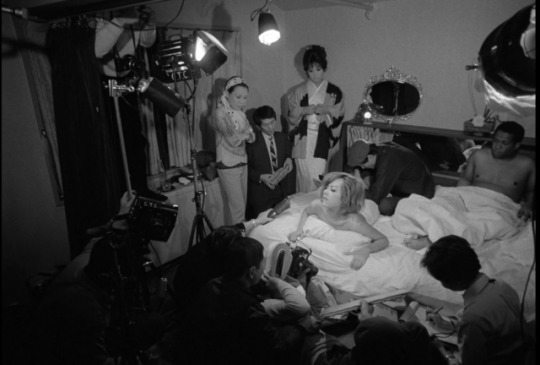
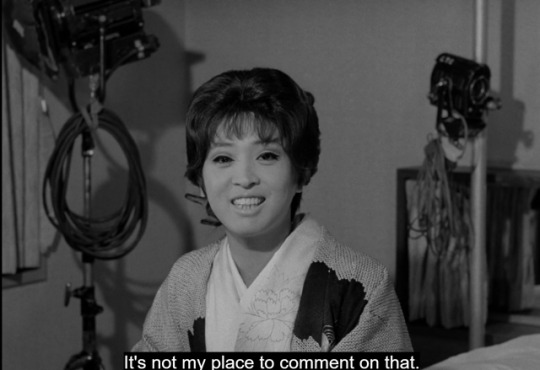
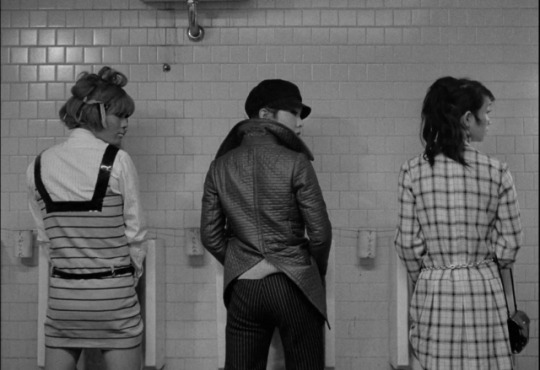
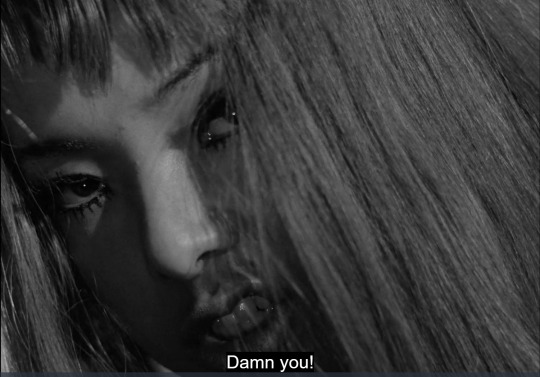



#112 Funeral Bed of Roses (1969)
Director: Tashio Matsumoto
Director of Photography: Tatsuro Suzuki
Japan
Gerow: While you eventually ended up a filmmaker, I heard that you originally wanted to be a painter. I wonder if you could talk about the relation between cinema and painting and why you decided on a career in film.
Matsumoto: Well, I loved painting. I had been painting since middle school, but Japan was very poor at the time I was about to enter college in the early 1950s. To do painting meant you weren't going to eat. Even so, I wanted to paint, but my parents were bitterly opposed to me going to an art school and said they wouldn't pay for art school examinations or tuition. In those days, there weren't part-time jobs around like there are today, so there was no way I could have done it on my own. So I gave up on art school and entered the medical course at the University of Tokyo because I was interested in the brain and problems like schizophrenia.
But even though I didn't necessarily grow to dislike that, I thought I had only one life to live and I wanted to pursue art. Without telling my parents, I changed my major half-way through to art and art history in the literature faculty. Tokyo, however, didn't really have any classes teaching you how to paint, so I studied art theory and history in school and learned painting on my own. In my studies, I learned for the first time that there was an avant-garde cinema in Europe in the 1920s that visually was deeply related to contemporary art--a fact that struck me like a bolt out of the blue. Though I couldn't see these films in Japan, I was strongly stimulated by foreign books and articles about them. I felt that this, an area where issues of art and cinema overlapped, was what I had been searching for.
Of course, I loved movies and went to see them a lot from the time I was in middle and high school. I was even treated like a juvenile delinquent and was arrested twice by the Shinjuku police because I skipped school. Well, I was that much in love with film, and I asked a friend of mine who had a stock holders pass--his father was in the theater business--to lend it to me, telling him I'd return it whenever he wanted to go. I'd go to school until noon and then go straight to Shinjuku where I'd see one movie after another, going into every first-run theater in Shinjuku from one end to another. To see all the first-run films in Shinjuku meant that I was seeing almost all the releases.
Source: yidff.jp: Matsumoto interview with Aaron Gerow
I’m not going to reconstruct the plot, because it might be more helpful for a first time viewer to reign in their expectations. So here’s my shopping list of divergent visual cues / associations that I encountered in this film:
Andy Warhol’s factory, Twiggy, Psychedelics, Victor Moscoso, Stanley Kubrick, Oedipus, Slasher films, Dada and Surrealism, Transvestites, Cinema verite, Pop art, Porn movie sets, Yukio Mishima, William S. Burroughs, David Lynch, Kitsch, Men as Geishas, Drug culture, and acid rock / carnival soundtrack.
Now, splice all this up into a non –linear narrative, and capture it in great black and white cinematography, and that’s what you’re going to get hit with for the duration of the film. Funeral Bed of Roses is an unforgettable movie on several levels.
One: This is a movie way ahead of its time. As a film that puts homosexuality front and center, this movie was half a century ahead on a topic that has only now made it safely into mainstream media, the fact that it emerges from Japan, is in some ways more startling. True, Japan does have a rich artistic tradition of merging sexuality, violence and the grotesque, but it is also known as a very traditional and highly repressed culture. Japan was also a culture struggling to artistically re-identify itself after being leveled by the fire bombings of World War II. Japan had to come to grips not only with its own past cultural heritage, or what was left of it, but also come to terms with its immanent and rapid post-war modernization.
Two: As an example of taking a somewhat bizarre and unorthodox approach to a classic myth (Oedipus), it’s not the first work of art to excavate this ominous Greek tragedy, but certainly one of the more unexpected adaptations you’ll ever see. The Oedipus translation emerges more clearly toward the end of the film, but our main character, Eddie (Pita) has issues with his condescending / abusive mother and his absent father. Because of the collage format of the film, these connections at first appear as abstract visuals with no context, but the story slowly gathers the fragments together into narrative cohesion.
Three: Stylistic treatment. From the opening visual, and really through to the finish- the cinematography is excellent. It is strong in terms of image, tonality, composition, cropping and graphic innovation, where it puts its black and white palette through a strobe -like psychedelic montage. If that wasn’t enough, there are passages of film where the male / female actors are interviewed about their homosexuality, and how they fit into this rarified part of Japanese subculture. These passages are quite beautiful, and rather disarming when we hear the blunt and deliberate answers to probing, personal questions. But these narrative and stylistic breaks add to the overall variety of visual texture in the film. Additionally, the movie is a joy to watch when it spills out onto the Tokyo streets, camera in tow. The reactions of bystanders as transvestites are filmed in a mock gang fight adds yet another unique layer to an already bizarre scenario.
Four: Picturesque eroticism. While not straightforward in its graphic representation of sex as a film like Realm of the Senses ( #31), it does treat the theme of eroticism and obsession in a visually alluring manner. Making sexuality and its accompanying psychic impulses into a visually intriguing confrontation has been with art forever, but in this film, its close stylistic counterpart is Surrealism. Literary stories like Georges Bataille’s Story of the Eye, or the sexual juxtapositions of the paintings of Rene Magritte, or Marcel Duchamp, come to mind when viewing this film. I’m not sure of the weight Matsumoto’s gives to his visual references, but whether he was channeling them or not, the Surrealists would have embraced this film immediately. They would have loved it, not only for its taboo subject matter, but for its cut-up compositional methodology.
The onset of the twentieth century saw the artistic avant–garde in both Europe and America taking the position to critique industrial culture, conservative institutions, and adapt the language of the machine age to explore emotional / sexual /psychic territory that culture uniformly tagged as forbidden. Abrasive content and uncomfortable depictions became the means for modern art to divest itself of sanitizing its messages in nineteenth century classicism, and confront its audience, however small, with some of the tangible and psychic brutalities of the modern era. With Matsumoto’s initial calling as a painter, for a film like Funeral Bed of Roses to emerge during the 1960’s makes perfect sense. At the last half of the twentieth century, two world wars, and conflict in Asia provide perfect conditions for this avant-garde film to freely pull from the file cabinet of counter-cultural iconography to piece together its unique contribution. The fifties and sixties saw the emergence of counter-culture and drugs making their way into mainstream consciousness, and this film is clearly a byproduct of this phenomenon. From its cinematic, self-referential passages to its historic allusions, it is in many ways a fledgling product of post modernism. This category /term would have been in its infancy at the time Matsumoto made this picture, but the historical and stylistic earmarks are there. Andy Warhol is often cited as the first post-modern artist. One who consciously adapted to and utilized images from commercial mass media, not merely as process, but in terms of content as well. They are very much products of the advertising / television age. Funeral Bed of Roses comes across in much the same manner, a transvestite geisha on a street corner as traffic speeds by serves as a very modern study in contrasts. Scenes of drug use and sexuality form a good deal of footage, topics and images that only a few decades prior would have been met with stringent censorship.
We get comfortable with certain expectations we have from movies. We want them to deliver certain things in certain ways, and to break these expectations is to invite scorn from the audience, or even worse, all out neglect. This is not always an easy movie to watch. Many won’t like the subject, many won’t like the treatment, many will be confused, some won’t even be patient with it being in black and white. But, this film is unique and certainly has more than its share of kooky and beautifully alluring visuals. It might be better to see it while you’re on psychedelics, I’m not really even sure about that, but that’s yet another layer this quirky film has to offer.
One of a kind.
https://filmjrnl365.tumblr.com
7 notes
·
View notes
Text
Home Entertainment Consumer Guide: December 27, 2018
10 NEW TO NETFLIX
"2 Fast 2 Furious" "Apocalypse Now" "Avengers: Infinity War" "Baby Mama" "The Fast and the Furious" "The Innocents" "Kill the Messenger" "The Little Hours" "Maps to the Stars" "The Theory of Everything"
8 NEW TO BLU-RAY/DVD
"Assassination Nation"
I'm only human and so there's a bit of an impulse to include a release in this column on which I'm quoted on the cover, even if the movie itself is something of a mixed bag. The quote "'Mean Girls' meets 'The Purge" is from my Sundance viewing of this divisive genre film, and is more descriptive than praising. What's been interesting to watch about the conversation around this abrasive, incendiary castigation of internet culture is that I have been very lonely in my middle ground opinion. I like its ideas more than its execution, but find it fascinating how many people either LOVE or HATE this movie. Honestly, we need more movies like that—movies that provoke conversation and debate. So you should see this not because I'm quoted on the cover but because you should pick a side ... or join me in the neutral zone.
Buy it here
Special Features Deleted/Extended Scenes Gag Reel Trailers
"Bad Times at the El Royale"
This is another movie that people seemed to either embrace or abhor and I finished with a shoulder shrug. Maybe that's not fair. I mostly liked Drew Goddard's single-setting bloodbath, but I'm stunned that anyone sees enough to like or hate here to include in either ten best or ten worst lists for the entirety of 2018. On the positive side, the ensemble is fantastic, especially Cynthia Erivo, Jeff Bridges, and Chris Hemsworth. It's never boring, weaving several subplots on a very bad night at the El Royale hotel into one backstabbing tapestry. It's also too long, too unfocused, and slips through your fingers once it's over. There's a tighter, smarter version of "El Royale" in this one that could have been great. But this one is still pretty good—available On Demand now and on Blu-ray on 1/1.
Buy it here
Special Features Making Bad Times at the El Royale Gallery
"Fahrenheit 11/9"
Did Michael Moore's latest provocation influence the election as he so clearly hoped it would when he dropped it in the heat of the season? Maybe. Probably not, though. The fact is that Moore doesn't have the impact he once did, but should that be the only way we judge him as a filmmaker? As an influencer? It will be interesting to see how his most overtly political films like this one stand up with a couple decades of history behind them. For me, the best pieces of "Fahrenheit 11/9" don't focus on the Trump Presidency but the various stories of the last few years that led to the voter apathy that was arguably the biggest reason he won. And, say what you will about this film's lack of focus, there's a great mini-doc buried within this film about the Flint water crisis that you really should see.
Buy it here
Special Features None
"The Predator"
After the TIFF premiere of Shane Black's latest reboot/sequel to the hit '80s sci-fi/action film, I suspected that I would be in the minority of critics who enjoyed it but didn't expect it to be quite so drastic. I stand by my 2am take in Canada that this is a fun action movie that understands what worked about the original film while also taking some of the same ideas in a new direction. No, it's not going to be anyone's favorite movie of 2018, but it's a quick, enjoyable rental on a Saturday night, and it works even better at home than in the middle of the night in Toronto.
Buy it here
Special Features Deleted Scenes A Touch of Black Predator Evolution The Takedown Team Predator Catch-Up Gallery
"Schindler's List"
Only this column could go from "The Predator" to "Schindler's List," but that's how we roll at the HECG (and the byproduct of alphabetical listings). For the 25th anniversary of one of the best films of the '90s, Universal has upgraded Steven Spielberg's Oscar winner with a 4K release that reminds viewers why this movie was so rapturously praised when it came out in 1993. Given 4 stars by Roger on its initial release, he didn't wait long to put it in the Great Movies pantheon, and it's a movie that has held up remarkably well. The 4K release is accompanied by a new documentary called "Schindler's List: 25 Years Later," adding to the sense that this is one of the essential 4K Blu-ray releases of 2018.
Buy it here
Special Features NEW 4K RESTORATION OF THE FILM SUPERVISED BY STEVEN SPIELBERG DOLBY VISION/HDR 10 PRESENTATION OF THE FILM NEW Schindler's List: 25 Years Later - Featurette NEW USC Shoah Foundation Story with Steven Spielberg (2018) Voices from the List - Featurette Let Their Testimonies Speak - Stronger Than Hate About IWitness (2018) AND MORE...
"A Simple Favor"
Paul Feig's mystery/comedy looked like a disaster before it was released. It was coming out at a time of year when studios are known for dumping movies that they don't know what to do with, and it didn't play any fests or get much in the way of critics screenings. And then it dropped and most people were pleasantly surprised. A reasonably big hit (almost $100 million worldwide), "A Simple Favor" filled a hole in storytelling for adults that Hollywood simply doesn't care about as much as they used to. In a time when the mid-budget movie is disappearing, it feels like everything is a part of a franchise or a low-budget indie. The mid-budget filmmakers went to TV. And so it's so heartening to see a solid mid-budget flick that offers a night of entertainment for grown-ups away from Netflix. I'm a little less high on the flick than everybody else (I think Blake Lively is amazing but the movie sags a bit when she's absent), but it's totally worth a rental.
Buy it here Special Features 3 Audio Commentaries with Cast and Crew 8 Featurettes Gag Reel Deleted Scenes Flash Mob
"Starman"
When the acolytes of John Carpenter talk about the horror icon, they often stick solely to, well, his horror films. How many pieces can the internet produce about the greatness of "Halloween," "The Thing," or underrated pics like "The Fog" and "Prince of Darkness"? Lost in a lot of the talk about Carpenter is what is actually his highest-grossing film outside of Mike Myers, 1984's "Starman." This has always been a film that I hold close to my heart as I was nine when it came out and, well, that's a good age for this movie. It's an underrated film with a truly great performance from Jeff Bridges. As Roger wrote 34 years ago, "Actors sometimes try to change their appearance; Bridges does something trickier, and tries to convince us that Jeff Bridges is not inhabited by himself."
Buy it here
Special Features NEW They Came from Hollywood: Re-visiting STARMAN – featuring director John Carpenter, actors Jeff Bridges, Charles Martin Smith and script supervisor Sandy King-Carpenter Audio Commentary with director John Carpenter and Jeff Bridges Vintage Featurette Teaser Trailer Theatrical Trailer TV Spots Still Gallery
"Venom"
Ah, "Venom." Is this smash hit a good movie? Noooo. It's clunky and weird. And yet there's something in here that almost brings it together and that's the totally committed lunacy from Tom Hardy. Whether he's talking to the symbiote inhabiting his body or eating a live lobster out of the tank in which he's sitting, there's something inspired in so many of his choices. Sadly, the rest of the movie totally pales in comparison, including something I didn't think was possible: flat performances from Riz Ahmed and Michelle Williams. As much as I don't want to see "Venom" again, I'll be curious about "Venom 2" just to see if Hardy's energy can be featured in a project that deserves it.
Buy it here
Special Features Venom Mode: When selecting this mode the film will engage informative pop-ups throughout the film to provide insight on the movie's relationship to the comics, and to reveal hidden references that even a seasoned Venom-fan may have missed! Deleted & Extended Scenes: These deleted and extended scenes will give fans even more of the Venom action they loved in theaters! Ride to Hospital – Eddie and Venom take a ride to the hospital. Car Alarm – Let's just say that Venom is not fond of car alarms. San Quentin – Extended post-credits scene at San Quentin. From Symbiote to Screen: A mini documentary about the history of Venom in comics and his journey to the big screen. Interviews with Avi Arad, Matt Tolmach, Ruben Fleischer, Oliver Scholl, and Director and Comic Fanboy Kevin Smith. The Lethal Protector in Action: Go behind the scenes with the production crew and learn the secrets behind the awesome Motorcycle stunts, wire stunts, and drones. Venom Vision: A look at how Ruben Fleischer came to the project, gathered his team, and made Venom a reality. Utilizes interviews from cast, crew, and producers as well as Fleischer himself. Designing Venom: Designing and creating Venom meant a huge challenge for VFX artists; follow the amazing journey. Symbiote Secrets: Blink and you may have missed it! Enjoy the hidden references throughout the film. 8 Select Scenes Pre-Vis sequences: See the progression of the visual effects, storyboards and fight chorography compared to the finished film. "Venom" by Eminem – Music Video "Sunflower" by Post Malone, Swae Lee (From Spider-Man: Into the Spider-Verse) Spider-Man: Into the Spider-Verse Sneak Peek: Meanwhile in another universe …
from All Content http://bit.ly/2EPZSPN
0 notes